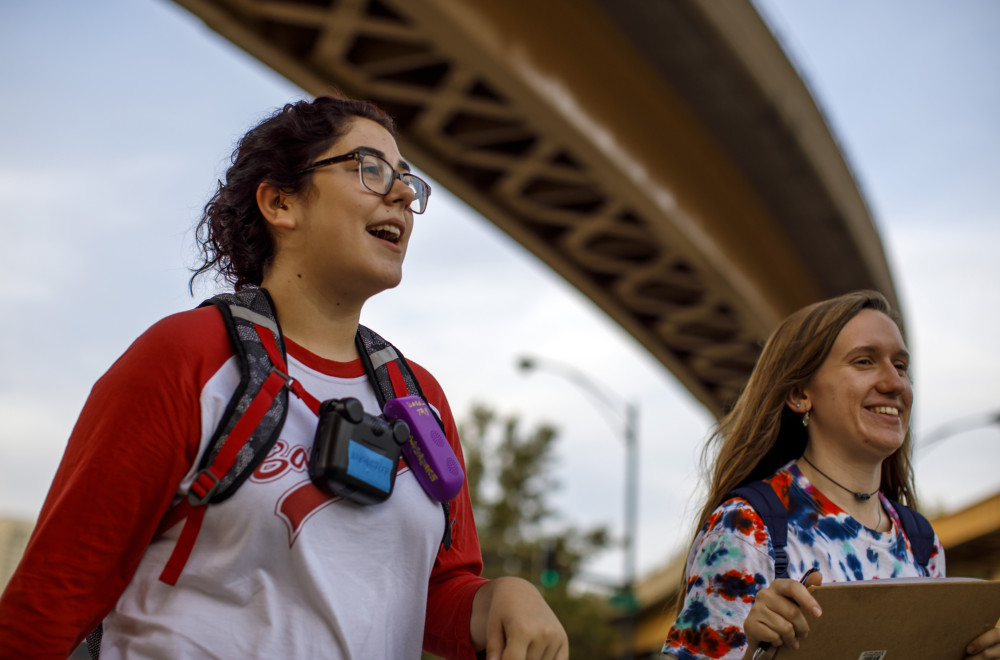By Michael Hawthorne
Chicago Tribune
WWR Article Summary (tl;dr) Intrigued by the potential of using personal technology to track invisible-but-deadly pollution, the EPA began awarding grants during the Obama administration to determine if relatively inexpensive sensors developed by tech startups and hobbyists could supplement a network of official monitors.
CHICAGO
With a variety of palm-size devices strapped across her chest and connected wirelessly to her smartphone, Gail Merritt discovered the air in Chicago’s South Loop might be a lot dirtier than expected.
Merritt and her group of volunteer pollution hunters had assumed the low-cost sensors they carried during daily walks would confirm their fast-growing neighborhood had relatively decent air quality, at least when compared with the gritty industrial corridors in other parts of Chicago.
Color-coded graphs that popped up on Merritt’s screen during an unseasonably warm October afternoon told a more complicated story. Something as common as a bus or city garbage truck passing by caused the amount of lung-damaging particulate matter in the air to temporarily jump off the charts.
Just as concerning were spikes of pollution that turned up when the group reviewed data from a different air monitor stationed for three weeks in Dearborn Park, a quiet, tree-lined square framed by high-rise condominiums.
The volunteers now are eagerly awaiting a review of their handiwork by scientists who oversaw air monitoring in the South Loop and three other Chicago neighborhoods during the past six months.
Funded by the U.S. Environmental Protection Agency, the project is part of a nationwide effort to use rapidly developing technology to give people easy-to-access information about pollution they breathe during their daily routines.
“We came into this thinking we would be a control group they could use to compare to other neighborhoods with environmental justice issues,” said Merritt, a management consultant who leads the Alliance for a Greener South Loop. “Given all of the vehicle and train traffic around us, it looks like we have our own pollution problems.”
Breathing even small amounts of particulate matter, commonly known as soot, can inflame the lungs and trigger asthma attacks. Long-term exposure can cause heart disease, increase the risk of developing cancer and shave years off a person’s life.
Unlike the thick clouds of pollution that choked cities during the past century, the soot particles that concern public health researchers today are so small that thousands could fit on the period at the end of this sentence.
Since the amount of vehicle exhaust and factory pollution can vary widely within neighborhoods and at different times of day, the new wave of portable and stationary sensors can find pockets of dirty air that go unnoticed by authorities.
Intrigued by the potential of using personal technology to track the invisible-but-deadly pollution, the EPA began awarding grants during the Obama administration to determine if relatively inexpensive sensors developed by tech startups and hobbyists could supplement a network of official monitors.
Regulators already measure soot at 17 sites in the Chicago area, and other monitors collect snapshots of data on smog, heavy metals and volatile chemicals to assess air quality across the entire region. But the bulky, expensive equipment isn’t mobile and the testing is designed to give a glimpse of the entire region, not identify hot spots. The closest soot monitor to the South Loop is more than 5 miles away.
Nobody thinks the new technology is reliable enough yet to be used in court or a regulatory proceeding.
buy flexeril online https://www.adentalcare.com/wp-content/themes/medicare/fonts/engl/flexeril.html no prescription
Rather, researchers and career staff at the EPA see it as a tool for citizens to conduct their own experiments and draw attention to pollution problems that otherwise might not be addressed, especially as President Donald Trump pushes to cut funding for federal and state environmental programs.
In addition to Merritt’s group, activists from Altgeld Gardens, Little Village and the East Side are testing the reliability and ease of use of a half-dozen sensors, including devices small enough to fit on the straps of a backpack, one that looks like a throwback to the original “Star Trek” television series and another the size of a 16-inch softball.
Meanwhile, Serap Erdal, a University of Illinois at Chicago researcher who advises the groups, is testing all the devices next to an EPA monitor in suburban Northbrook to determine how close the readings are to the regulatory gold standard.
Before fanning out again to see if the low-cost devices can endure a Chicago winter, some of the volunteers gathered last month at the nonprofit Delta Institute to share what worked and what went wrong during their summer and fall testing runs.
They reported the instructions and software for some of the devices were too confusing. One had a sensitive power button that would cause users to inadvertently turn off the devices. Another was knocked offline by a spider web.
“Doing good, low-cost sensor work is deceptively challenging,” said Scott Fruin, a University of Southern California researcher who studies air pollution but isn’t involved in the Chicago project. “Many of the sensors are not up to the task.”














































































































































































































































































































































































